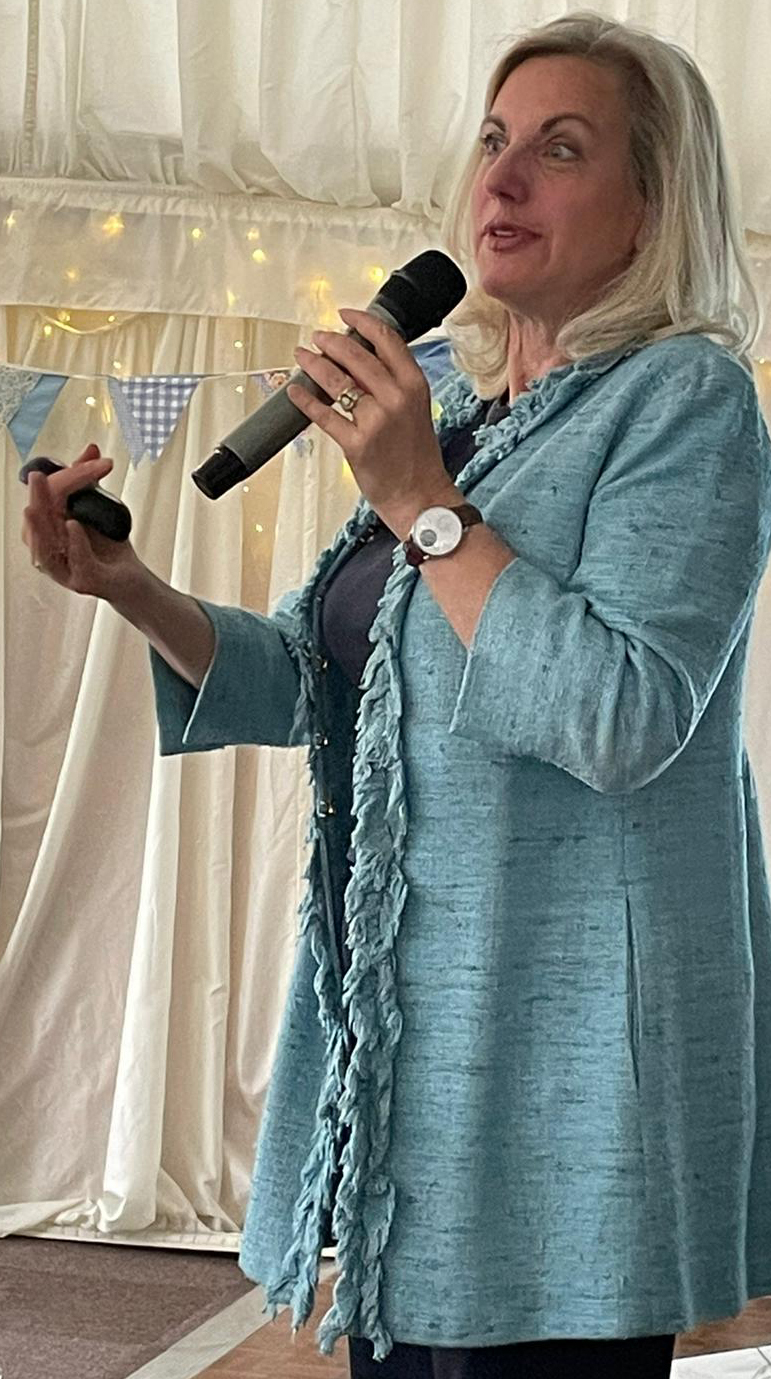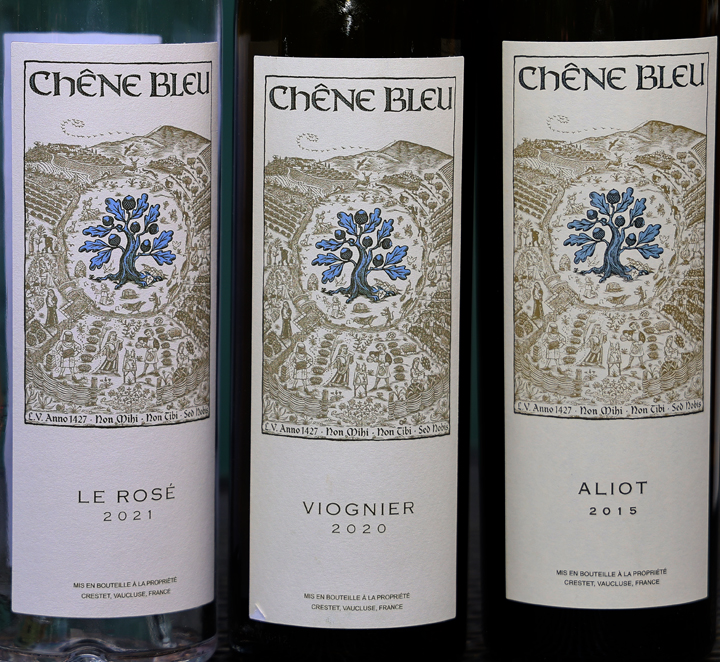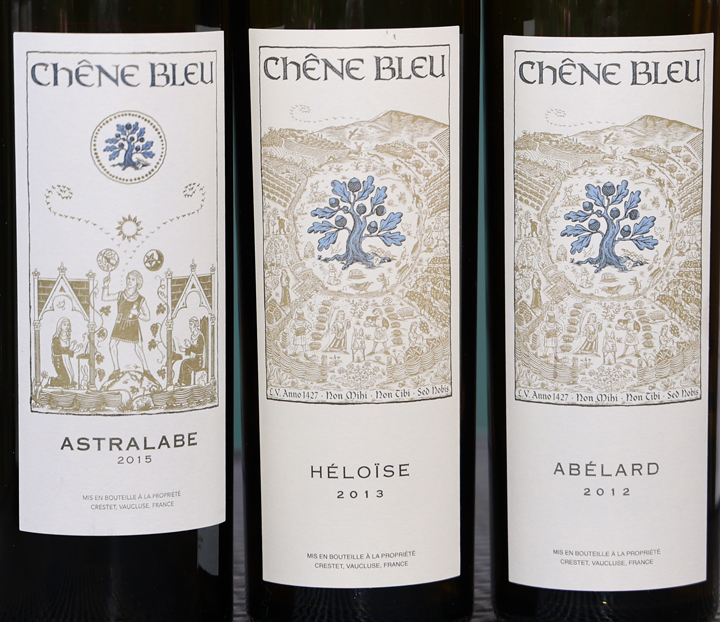 Introducing Nicole Rolet and the biodynamic wines of Chêne Bleu, Hilary Reid Evans commented that when they purchased the derelict property in 1993, neither Nicole nor her husband Xavier had any prior experience of wine making or the wine trade. During the intervening period, the reputation of the wines of Chêne Bleu has grown year on year and have been described as the ‘world’s first super Rhônes’ by the Wall Street Journal and have gathered the highest Parker scores for their reds as well as Jancis Robinson’s highest ever scores for their rosés. Not so much a rising star as a ‘shining star in the wine making firmament’.
Introducing Nicole Rolet and the biodynamic wines of Chêne Bleu, Hilary Reid Evans commented that when they purchased the derelict property in 1993, neither Nicole nor her husband Xavier had any prior experience of wine making or the wine trade. During the intervening period, the reputation of the wines of Chêne Bleu has grown year on year and have been described as the ‘world’s first super Rhônes’ by the Wall Street Journal and have gathered the highest Parker scores for their reds as well as Jancis Robinson’s highest ever scores for their rosés. Not so much a rising star as a ‘shining star in the wine making firmament’.
Nicole Rolet freely admitted to Wine Club members that they make their wines for the 0.01% of people on the planet who love and love to explore wines. Located in the heart of the Southern Rhône, the Chêne Bleu vineyards are located in the mountains at the juncture of four appelations – Ventoux, Séguret, Gigondas and Côtes du Rhône. Their altitude means the vineyard has cooler climatic conditions than their latitude might imply, with harvesting taking place in late September or early October. Using the Chêne Bleu vineyard as her example, Nicole explained the difference between appellation and terroir.
Due to their geology (there is a tectonic plate edge in their ‘backyard’), location, erosion and consequent lack of depth of topsoil (the vineyard ‘vomits rocks’ according to Nicole) the roots of the vines are forced to grow deep into the ground in order to seek water. Some of the older Grenache vines have roots that reach 100m down. The soil types are multiple and ancient, giving a complex minerality to the wines.
Speaking about their rosé wines, Nicole pointed out that rosés were not fashionable when they first started making them. From their early days as a grenache/syrah blend they have developed the wines year on year, seeing to produce a wine that is not insipid, has length, complexity and ageability, as well as being ‘charming and flirtatious’. Their aim is to keep the aromatic curve of the wine long, avoiding any flat lining after the initial taste and avoiding a bitter finish. In their 7th year of rosé production Chêne Bleu won Richard Bampfield’s world rosé challenge. In the production process, Chêne Bleu do not use polyvinyl polypropylene (a microplastic) but instead use ground organic pea powder. Neither is any tartaric acid used in the production process, unlike most of the rosés of Provence, who use it to increase the acidity of the wines. Unlike the aforementioned rosés, the Chêne Bleu rosés can be kept for around 2 years. Chêne Bleu uses a balloon press, first pressing of the grapes and dry ice to ensure freshness.
 Le Rosé 2021 – Grenache (60%), Syrah (20%), Mouvèdre (14%), Rolle (6%) ABV 13.5%, Residual sugar 0/5g/l
Le Rosé 2021 – Grenache (60%), Syrah (20%), Mouvèdre (14%), Rolle (6%) ABV 13.5%, Residual sugar 0/5g/l
Pale pink in colour, on the nose the wine is rich and intense with notes of redcurrants and some citrus. On the palate the wine is surprisingly fleshy and crisp, with citrus and red fruit flavours.
Moving on to the Viognier, Nicole pointed out that Chêne Bleu has one foot in the Southern and one in the Northern Rhône. Due to the altitude of the vineyards, the profile of the property is more like that to be found in the area around Condrieu. The Viognier of Chêne Bleu spends around 8 months in demi-muids. The aim is to make a wine that does not have the overwhelming quality on the nose that some highly concentrated Viogniers can have.
Viognier 2020 – 100% Viognier, ABV 14%, Residual sugar 2g/l
Bright and clear with some lemon-yellow hues, on the nose and palate the wine has notes of almonds, apricots and butter. The finish is long. The wine has an ageing potential of around 4-5 years. (There were mutterings of lovely around the room!)
Describing the Aliot 2015, Nicole commented that this is the only Chêne Bleu wine that is co-fermented. Aromatic in its youth, the wine will go through a closed period and may appear oxidated, before finding its layers of complexity. The 2008 is currently drinking well. She suggested that perhaps drinking the 2015 is ‘infanticide’! The Aliot is named after one of the ancient inhabitants of the property, who was a glass blower (hence the property’s name, La Verrière).
Aliot 2015 – Roussanne (65%), Grenache blanc (30%), Marsanne (5%) plus a ‘touch’ of Viognier. ABV 14%, Residual sugar 1.8 g/l
Golden yellow in appearance. On the nose rich and complex, some almonds and brioche. Fresh with hints of acidity and some minerality on the palate. Long and intense.
Named after the son of Abelard and Heloise, Astralabe these three wines for a trilogy, the Astralabe being designed to drink younger than the ‘parent’ wines, all three are Grenache Syrah blends. Ageing potential is 3-5 years. Club members were able to taste a more aged Astralabe, the 2015.
 Astralabe 2015 – Grenache noir (80%), Syrah (20%), ABV 14%, Residual sugar 0.5g/l
Astralabe 2015 – Grenache noir (80%), Syrah (20%), ABV 14%, Residual sugar 0.5g/l
A rich ruby colour, on the nose there were notes of ripe fresh red fruits and some floral hints. On the palate, the wine was smooth, full-bodied and with fine but not overwhelming tannins. The finish was long with some spices coming through on the back palate.
Nicole described the next wines, served as a pair, as ‘feathers and fur’ because of their food affinities. The Héloïse was described as having ‘sex appeal’ and Nicole stated that it is more of a restrained Northern Rhône style of wine than the Abélard, which she in turn described as a Southern Rhône ‘big boy’ and an alternative to Châteauneuf du Pape. The Grenache and Syrah vines from which these wines are made are all over 50 years old. Both wines spend c 18 months in French oak.
Héloïse 2013 Syrah (65%), Grenache noir (31%), Roussanne (4%). ABV 14%, Residual sugar 0.6g/l
Deep crimson in colour, with slight signs of age on the rim. On the nose and palate, some mature dark fruits with a hint of truffle. A long finish. Will age for 10-12 years.
Abélard 2012 Grenache (85%), Syrah (15%) ABV 14.5% Residual sugar 0.5g/l
Deep and dark garnet red in colour, on the nose and palate the wine has hints of ripe cherries, blackberries and plums, with some sweet spices. Some oak on nose and soft oak tannins on palate. The finish is full bodied, long and rich.
As well as introducing the wines, Nicole found time to explain to a rapt audience the story of Abélard and Héloïse, the significance of rabbits to the biosphere and the origins of the Chêne Bleu label, which summarises the ‘cv’ of the wine. She also inducted those present into the ‘international bunny club’, with its own unique handshake. If you were not there, ask someone who was how it goes!
During the Q&A session, Nicole explained that production is constrained by the number of hectares under production (30, producing at 25 hectolitres per hectare) and that expansion would only be possible if they considered new plantings, purchasing new vineyards or buying in grapes. They are increasing the organic matter content of their soils using biodynamic crop rotation in a 10-15 year plan to increase yields. The red wines are therefore generally on allocation, because of high demand.
Giving the vote of thanks, Graham Harding and commenting on the attention to detail Chêne Bleu brought to their wines and marketing materials, he brought a tear to Nicole’s eye. She exclaimed in response that his words were amongst the kindest anyone had ever said after a tasting.
Altogether a memorable evening.
HRE 1.7.22